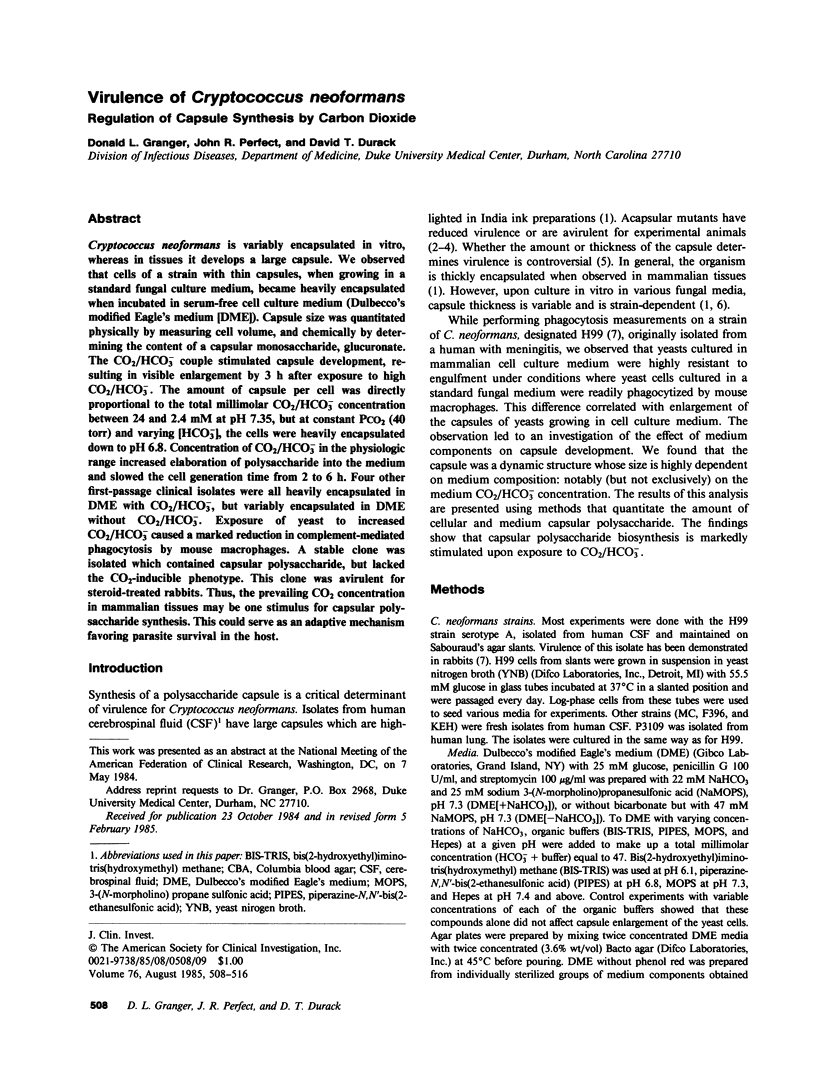Abstract
Cryptococcus neoformans is variably encapsulated in vitro, whereas in tissues it develops a large capsule. We observed that cells of a strain with thin capsules, when growing in a standard fungal culture medium, became heavily encapsulated when incubated in serum-free cell culture medium (Dulbecco's modified Eagle's medium [DME]). Capsule size was quantitated physically by measuring cell volume, and chemically by determining the content of a capsular monosaccharide, glucuronate. The CO2/HCO-3 couple stimulated capsule development, resulting in visible enlargement by 3 h after exposure to high CO2/HCO-3. The amount of capsule per cell was directly proportional to the total millimolar CO2/HCO-3 concentration between 24 and 2.4 mM at pH 7.35, but at constant PCO2 (40 torr) and varying [HCO-3], the cells were heavily encapsulated down to pH 6.8. Concentration of CO2/HCO-3 in the physiologic range increased elaboration of polysaccharide into the medium and slowed the cell generation time from 2 to 6 h. Four other first-passage clinical isolates were all heavily encapsulated in DME with CO2/HCO-3, but variably encapsulated in DME without CO2/HCO-3. Exposure of yeast to increased CO2/HCO-3 caused a marked reduction in complement-mediated phagocytosis by mouse macrophages. A stable clone was isolated which contained capsular polysaccharide, but lacked the CO2-inducible phenotype. This clone was avirulent for steroid-treated rabbits. Thus, the prevailing CO2 concentration in mammalian tissues may be one stimulus for capsular polysaccharide synthesis. This could serve as an adaptive mechanism favoring parasite survival in the host.
Full text
PDF








Images in this article
Selected References
These references are in PubMed. This may not be the complete list of references from this article.
- Anna E. J. Rapid in vitro capsule production by cryptococci. Am J Med Technol. 1979 Jun;45(6):585–588. [PubMed] [Google Scholar]
- Bhattacharjee A. K., Kwon-Chung K. J., Glaudemans C. P. Structural studies on the major, capsular polysaccharide from Cryptococcus bacillisporus serotype B. Carbohydr Res. 1980 Jun;82(1):103–111. doi: 10.1016/s0008-6215(00)85524-x. [DOI] [PubMed] [Google Scholar]
- Blumenkrantz N., Asboe-Hansen G. New method for quantitative determination of uronic acids. Anal Biochem. 1973 Aug;54(2):484–489. doi: 10.1016/0003-2697(73)90377-1. [DOI] [PubMed] [Google Scholar]
- Bulmer G. S., Sans M. D., Gunn C. M. Cryptococcus neoformans. I. Nonencapsulated mutants. J Bacteriol. 1967 Nov;94(5):1475–1479. doi: 10.1128/jb.94.5.1475-1479.1967. [DOI] [PMC free article] [PubMed] [Google Scholar]
- Diamond R. D., May J. E., Kane M. A., Frank M. M., Bennett J. E. The role of the classical and alternate complement pathways in host defenses against Cryptococcus neoformans infection. J Immunol. 1974 Jun;112(6):2260–2270. [PubMed] [Google Scholar]
- Dykstra M. A., Friedman L., Murphy J. W. Capsule size of Cryptococcus neoformans: control and relationship to virulence. Infect Immun. 1977 Apr;16(1):129–135. doi: 10.1128/iai.16.1.129-135.1977. [DOI] [PMC free article] [PubMed] [Google Scholar]
- Farhi F., Bulmer G. S., Tacker J. R. Cryptococcus neoformans IV. The Not-So-Encapsulated Yeast. Infect Immun. 1970 Jun;1(6):526–531. doi: 10.1128/iai.1.6.526-531.1970. [DOI] [PMC free article] [PubMed] [Google Scholar]
- Fromtling R. A., Shadomy H. J. Immunity in cryptococcosis: an overview. Mycopathologia. 1982 Mar 19;77(3):183–190. doi: 10.1007/BF00518804. [DOI] [PubMed] [Google Scholar]
- Fromtling R. A., Shadomy H. J., Jacobson E. S. Decreased virulence in stable, acapsular mutants of cryptococcus neoformans. Mycopathologia. 1982 Jul 23;79(1):23–29. doi: 10.1007/BF00636177. [DOI] [PubMed] [Google Scholar]
- Granger D. L., Taintor R. R., Cook J. L., Hibbs J. B., Jr Injury of neoplastic cells by murine macrophages leads to inhibition of mitochondrial respiration. J Clin Invest. 1980 Feb;65(2):357–370. doi: 10.1172/JCI109679. [DOI] [PMC free article] [PubMed] [Google Scholar]
- Griffin F. M., Jr Roles of macrophage Fc and C3b receptors in phagocytosis of immunologically coated Cryptococcus neoformans. Proc Natl Acad Sci U S A. 1981 Jun;78(6):3853–3857. doi: 10.1073/pnas.78.6.3853. [DOI] [PMC free article] [PubMed] [Google Scholar]
- Huang C. T., Lyons H. A. The maintenance of acid-base balance between cerebrospinal fluid and arterial blood in patients with chronic respiratory disorders. Clin Sci. 1966 Oct;31(2):273–284. [PubMed] [Google Scholar]
- Jacobson E. S., Ayers D. J., Harrell A. C., Nicholas C. C. Genetic and phenotypic characterization of capsule mutants of Cryptococcus neoformans. J Bacteriol. 1982 Jun;150(3):1292–1296. doi: 10.1128/jb.150.3.1292-1296.1982. [DOI] [PMC free article] [PubMed] [Google Scholar]
- Kozel T. R., Cazin J. Nonencapsulated Variant of Cryptococcus neoformans I. Virulence Studies and Characterization of Soluble Polysaccharide. Infect Immun. 1971 Feb;3(2):287–294. doi: 10.1128/iai.3.2.287-294.1971. [DOI] [PMC free article] [PubMed] [Google Scholar]
- Kozel T. R., Highison B., Stratton C. J. Localization on encapsulated Cryptococcus neoformans of serum components opsonic for phagocytosis by macrophages and neutrophils. Infect Immun. 1984 Feb;43(2):574–579. doi: 10.1128/iai.43.2.574-579.1984. [DOI] [PMC free article] [PubMed] [Google Scholar]
- LITTMAN M. L. Capsule synthesis by Cryptococcus neoformans. Trans N Y Acad Sci. 1958 May;20(7):623–648. doi: 10.1111/j.2164-0947.1958.tb00625.x. [DOI] [PubMed] [Google Scholar]
- Perfect J. R., Lang S. D., Durack D. T. Chronic cryptococcal meningitis: a new experimental model in rabbits. Am J Pathol. 1980 Oct;101(1):177–194. [PMC free article] [PubMed] [Google Scholar]
- Perfect J. R., Lang S. D., Durack D. T. Influence of agglutinating antibody in experimental cryptococcal meningitis. Br J Exp Pathol. 1981 Dec;62(6):595–599. [PMC free article] [PubMed] [Google Scholar]
- Pringle J. R., Mor J. R. Methods for monitoring the growth of yeast cultures and for dealing with the clumping problem. Methods Cell Biol. 1975;11:131–168. doi: 10.1016/s0091-679x(08)60320-9. [DOI] [PubMed] [Google Scholar]
- Rothman L. B., Cabib E. Allosteric properties of yeast glycogen synthetase. I. General kinetic study. Biochemistry. 1967 Jul;6(7):2098–2112. doi: 10.1021/bi00859a030. [DOI] [PubMed] [Google Scholar]





